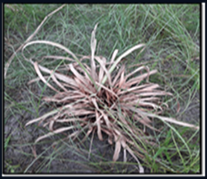Grassy Shoot Disease
Grassy Shoot Disease
The GSD was first observed by Barber (1919) & reported by vasudeva (1955) from Belapur, Maharashtra. The disease has been recorded in most of the sugarcane growing belt in India since then but the incidence being particularly high in Maharashtra.
Symptoms
• The disease is distinguished by formation of abundant tillers from the bottom of the diseased plants.
• The leaves turn pale yellow to entirely chlorotic and become small narrow and thin.
• The length of the internodes is reduced and grassy appearances of the whole clumps were observed.
• The colours of the entire clumps become whitish and hardly produce one or two canes which do not produce any millable canes and inflorescences.



